Toyota's Management and Operations: Leadership and Decision Making
VerifiedAdded on 2023/02/02
|15
|4673
|32
Report
AI Summary
This report provides a comprehensive analysis of Toyota's management and operations, focusing on leadership styles, the roles of leaders and managers, and the application of different management theories. It compares and contrasts the characteristics of leaders and managers within Toyota's hierarchical structure, examining how they adapt to various situations, such as organizational changes and rising costs. The report delves into leadership approaches like the Big Five personality traits and transformational/transactional leadership, while also highlighting key operational functions. Furthermore, it explores the impact of external business environment factors on the decision-making processes of Toyota's leaders and managers, providing insights into how the company navigates challenges and maintains its competitive edge in the automotive industry.
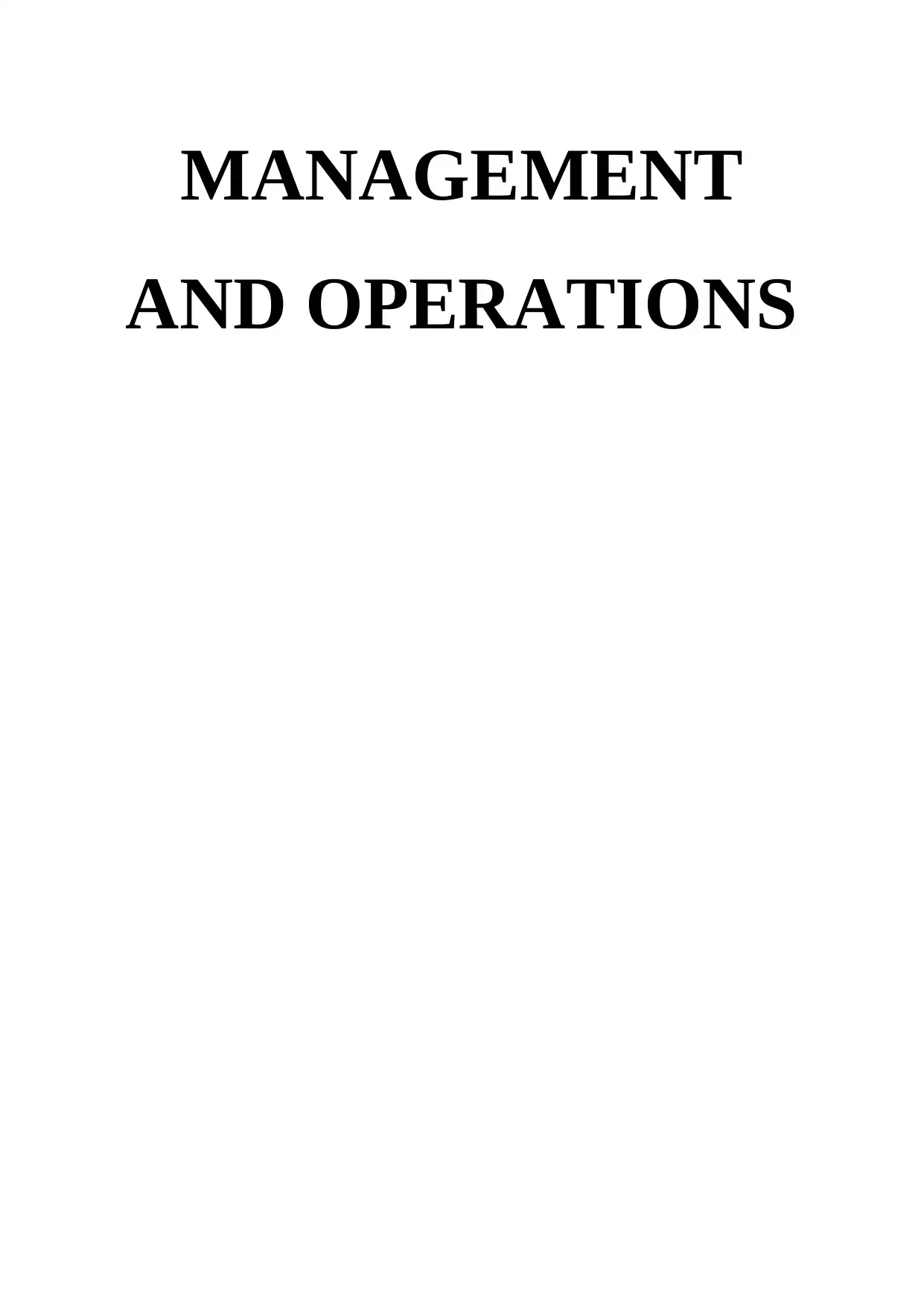
MANAGEMENT
AND OPERATIONS
AND OPERATIONS
Paraphrase This Document
Need a fresh take? Get an instant paraphrase of this document with our AI Paraphraser
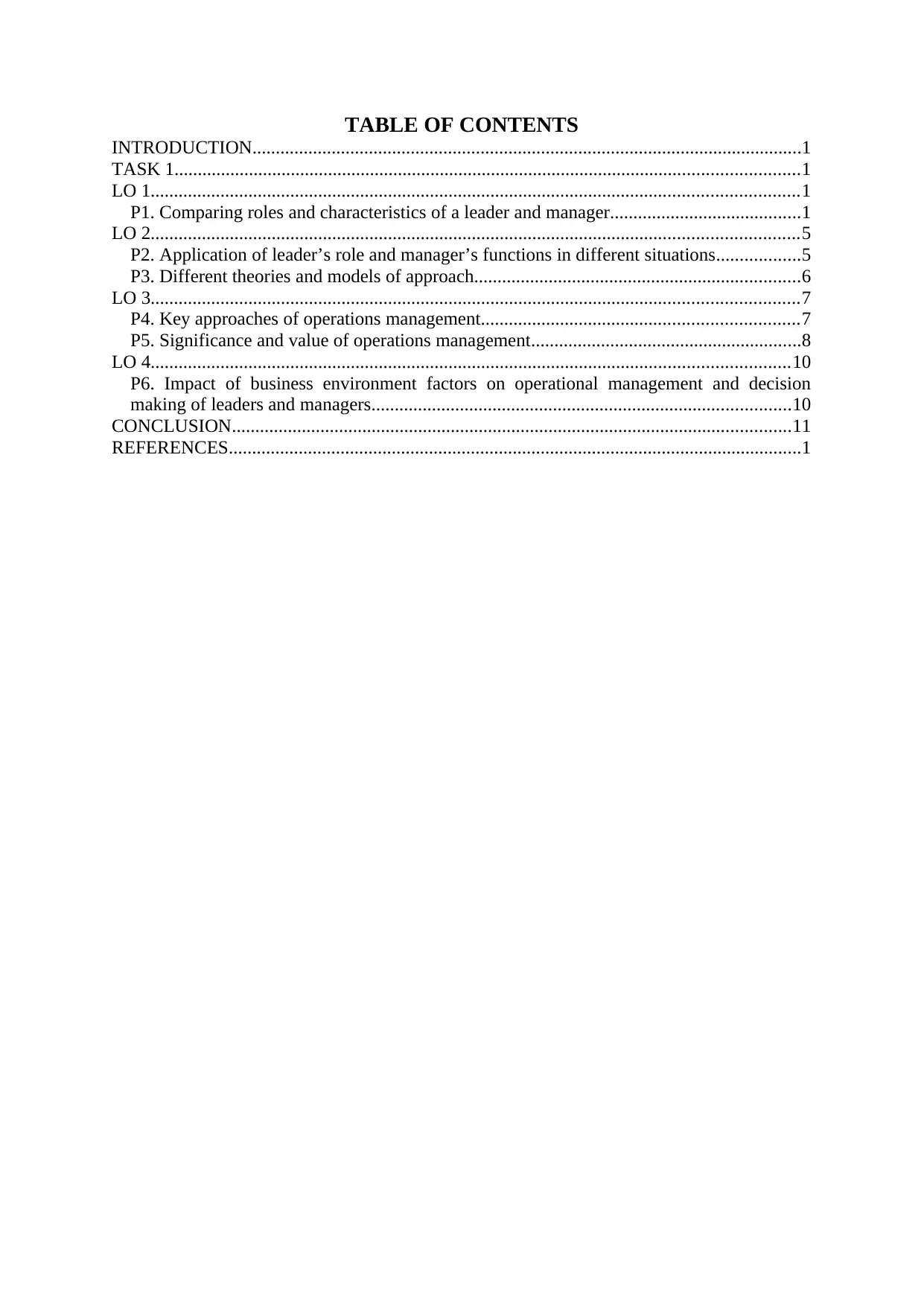
TABLE OF CONTENTS
INTRODUCTION......................................................................................................................1
TASK 1......................................................................................................................................1
LO 1...........................................................................................................................................1
P1. Comparing roles and characteristics of a leader and manager.........................................1
LO 2...........................................................................................................................................5
P2. Application of leader’s role and manager’s functions in different situations..................5
P3. Different theories and models of approach......................................................................6
LO 3...........................................................................................................................................7
P4. Key approaches of operations management....................................................................7
P5. Significance and value of operations management..........................................................8
LO 4.........................................................................................................................................10
P6. Impact of business environment factors on operational management and decision
making of leaders and managers..........................................................................................10
CONCLUSION........................................................................................................................11
REFERENCES...........................................................................................................................1
INTRODUCTION......................................................................................................................1
TASK 1......................................................................................................................................1
LO 1...........................................................................................................................................1
P1. Comparing roles and characteristics of a leader and manager.........................................1
LO 2...........................................................................................................................................5
P2. Application of leader’s role and manager’s functions in different situations..................5
P3. Different theories and models of approach......................................................................6
LO 3...........................................................................................................................................7
P4. Key approaches of operations management....................................................................7
P5. Significance and value of operations management..........................................................8
LO 4.........................................................................................................................................10
P6. Impact of business environment factors on operational management and decision
making of leaders and managers..........................................................................................10
CONCLUSION........................................................................................................................11
REFERENCES...........................................................................................................................1
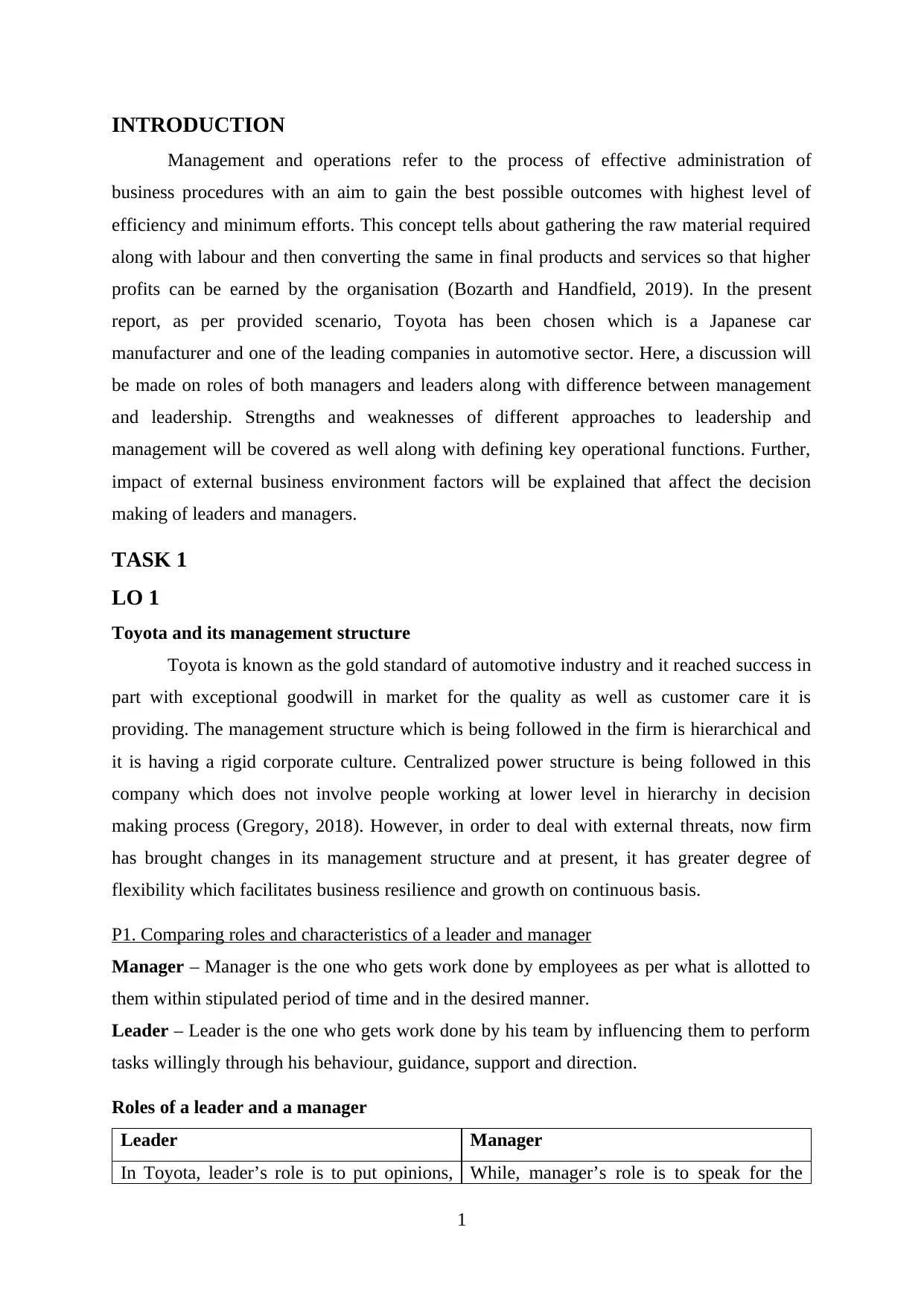
INTRODUCTION
Management and operations refer to the process of effective administration of
business procedures with an aim to gain the best possible outcomes with highest level of
efficiency and minimum efforts. This concept tells about gathering the raw material required
along with labour and then converting the same in final products and services so that higher
profits can be earned by the organisation (Bozarth and Handfield, 2019). In the present
report, as per provided scenario, Toyota has been chosen which is a Japanese car
manufacturer and one of the leading companies in automotive sector. Here, a discussion will
be made on roles of both managers and leaders along with difference between management
and leadership. Strengths and weaknesses of different approaches to leadership and
management will be covered as well along with defining key operational functions. Further,
impact of external business environment factors will be explained that affect the decision
making of leaders and managers.
TASK 1
LO 1
Toyota and its management structure
Toyota is known as the gold standard of automotive industry and it reached success in
part with exceptional goodwill in market for the quality as well as customer care it is
providing. The management structure which is being followed in the firm is hierarchical and
it is having a rigid corporate culture. Centralized power structure is being followed in this
company which does not involve people working at lower level in hierarchy in decision
making process (Gregory, 2018). However, in order to deal with external threats, now firm
has brought changes in its management structure and at present, it has greater degree of
flexibility which facilitates business resilience and growth on continuous basis.
P1. Comparing roles and characteristics of a leader and manager
Manager – Manager is the one who gets work done by employees as per what is allotted to
them within stipulated period of time and in the desired manner.
Leader – Leader is the one who gets work done by his team by influencing them to perform
tasks willingly through his behaviour, guidance, support and direction.
Roles of a leader and a manager
Leader Manager
In Toyota, leader’s role is to put opinions, While, manager’s role is to speak for the
1
Management and operations refer to the process of effective administration of
business procedures with an aim to gain the best possible outcomes with highest level of
efficiency and minimum efforts. This concept tells about gathering the raw material required
along with labour and then converting the same in final products and services so that higher
profits can be earned by the organisation (Bozarth and Handfield, 2019). In the present
report, as per provided scenario, Toyota has been chosen which is a Japanese car
manufacturer and one of the leading companies in automotive sector. Here, a discussion will
be made on roles of both managers and leaders along with difference between management
and leadership. Strengths and weaknesses of different approaches to leadership and
management will be covered as well along with defining key operational functions. Further,
impact of external business environment factors will be explained that affect the decision
making of leaders and managers.
TASK 1
LO 1
Toyota and its management structure
Toyota is known as the gold standard of automotive industry and it reached success in
part with exceptional goodwill in market for the quality as well as customer care it is
providing. The management structure which is being followed in the firm is hierarchical and
it is having a rigid corporate culture. Centralized power structure is being followed in this
company which does not involve people working at lower level in hierarchy in decision
making process (Gregory, 2018). However, in order to deal with external threats, now firm
has brought changes in its management structure and at present, it has greater degree of
flexibility which facilitates business resilience and growth on continuous basis.
P1. Comparing roles and characteristics of a leader and manager
Manager – Manager is the one who gets work done by employees as per what is allotted to
them within stipulated period of time and in the desired manner.
Leader – Leader is the one who gets work done by his team by influencing them to perform
tasks willingly through his behaviour, guidance, support and direction.
Roles of a leader and a manager
Leader Manager
In Toyota, leader’s role is to put opinions, While, manager’s role is to speak for the
1
⊘ This is a preview!⊘
Do you want full access?
Subscribe today to unlock all pages.

Trusted by 1+ million students worldwide
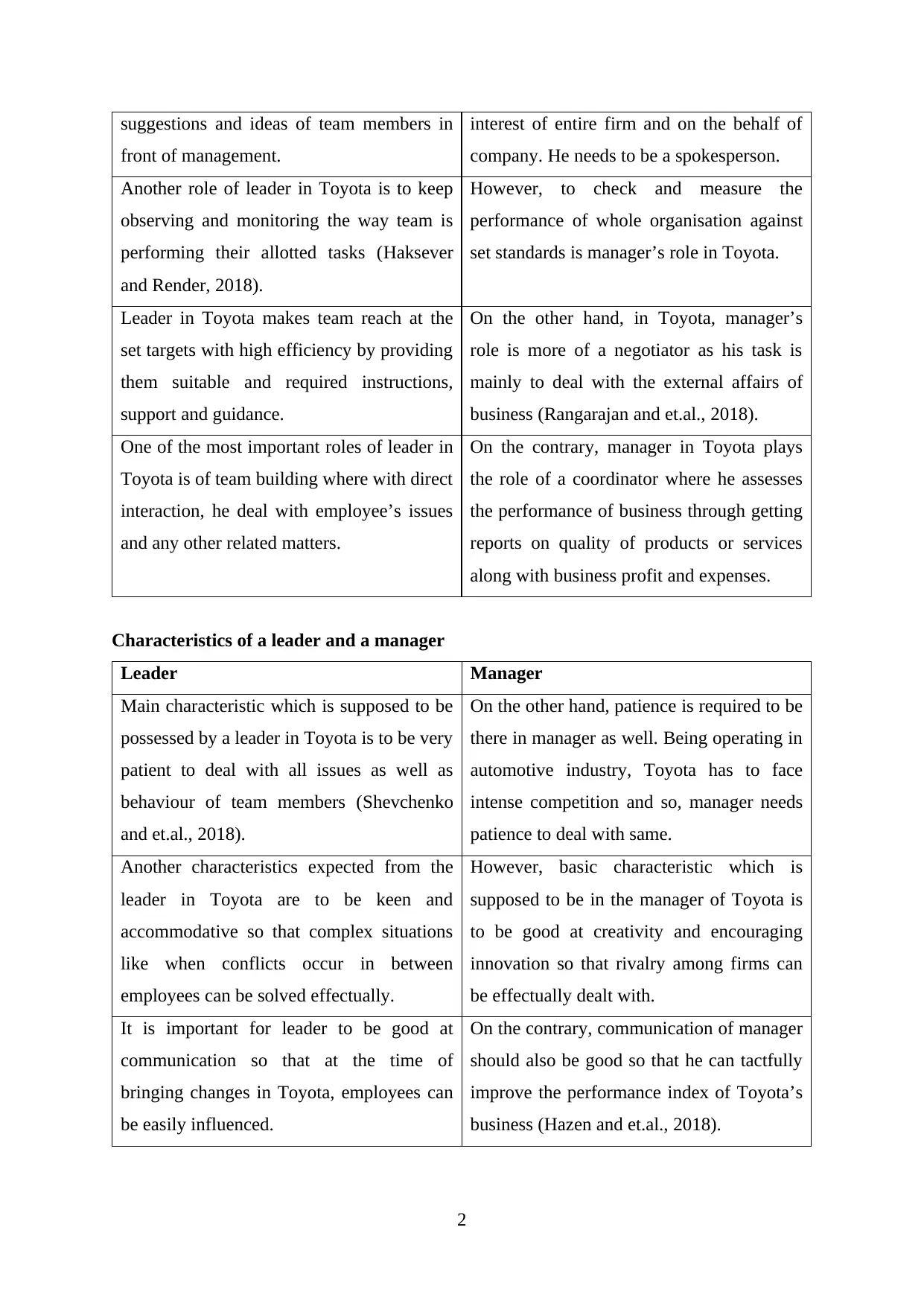
suggestions and ideas of team members in
front of management.
interest of entire firm and on the behalf of
company. He needs to be a spokesperson.
Another role of leader in Toyota is to keep
observing and monitoring the way team is
performing their allotted tasks (Haksever
and Render, 2018).
However, to check and measure the
performance of whole organisation against
set standards is manager’s role in Toyota.
Leader in Toyota makes team reach at the
set targets with high efficiency by providing
them suitable and required instructions,
support and guidance.
On the other hand, in Toyota, manager’s
role is more of a negotiator as his task is
mainly to deal with the external affairs of
business (Rangarajan and et.al., 2018).
One of the most important roles of leader in
Toyota is of team building where with direct
interaction, he deal with employee’s issues
and any other related matters.
On the contrary, manager in Toyota plays
the role of a coordinator where he assesses
the performance of business through getting
reports on quality of products or services
along with business profit and expenses.
Characteristics of a leader and a manager
Leader Manager
Main characteristic which is supposed to be
possessed by a leader in Toyota is to be very
patient to deal with all issues as well as
behaviour of team members (Shevchenko
and et.al., 2018).
On the other hand, patience is required to be
there in manager as well. Being operating in
automotive industry, Toyota has to face
intense competition and so, manager needs
patience to deal with same.
Another characteristics expected from the
leader in Toyota are to be keen and
accommodative so that complex situations
like when conflicts occur in between
employees can be solved effectually.
However, basic characteristic which is
supposed to be in the manager of Toyota is
to be good at creativity and encouraging
innovation so that rivalry among firms can
be effectually dealt with.
It is important for leader to be good at
communication so that at the time of
bringing changes in Toyota, employees can
be easily influenced.
On the contrary, communication of manager
should also be good so that he can tactfully
improve the performance index of Toyota’s
business (Hazen and et.al., 2018).
2
front of management.
interest of entire firm and on the behalf of
company. He needs to be a spokesperson.
Another role of leader in Toyota is to keep
observing and monitoring the way team is
performing their allotted tasks (Haksever
and Render, 2018).
However, to check and measure the
performance of whole organisation against
set standards is manager’s role in Toyota.
Leader in Toyota makes team reach at the
set targets with high efficiency by providing
them suitable and required instructions,
support and guidance.
On the other hand, in Toyota, manager’s
role is more of a negotiator as his task is
mainly to deal with the external affairs of
business (Rangarajan and et.al., 2018).
One of the most important roles of leader in
Toyota is of team building where with direct
interaction, he deal with employee’s issues
and any other related matters.
On the contrary, manager in Toyota plays
the role of a coordinator where he assesses
the performance of business through getting
reports on quality of products or services
along with business profit and expenses.
Characteristics of a leader and a manager
Leader Manager
Main characteristic which is supposed to be
possessed by a leader in Toyota is to be very
patient to deal with all issues as well as
behaviour of team members (Shevchenko
and et.al., 2018).
On the other hand, patience is required to be
there in manager as well. Being operating in
automotive industry, Toyota has to face
intense competition and so, manager needs
patience to deal with same.
Another characteristics expected from the
leader in Toyota are to be keen and
accommodative so that complex situations
like when conflicts occur in between
employees can be solved effectually.
However, basic characteristic which is
supposed to be in the manager of Toyota is
to be good at creativity and encouraging
innovation so that rivalry among firms can
be effectually dealt with.
It is important for leader to be good at
communication so that at the time of
bringing changes in Toyota, employees can
be easily influenced.
On the contrary, communication of manager
should also be good so that he can tactfully
improve the performance index of Toyota’s
business (Hazen and et.al., 2018).
2
Paraphrase This Document
Need a fresh take? Get an instant paraphrase of this document with our AI Paraphraser
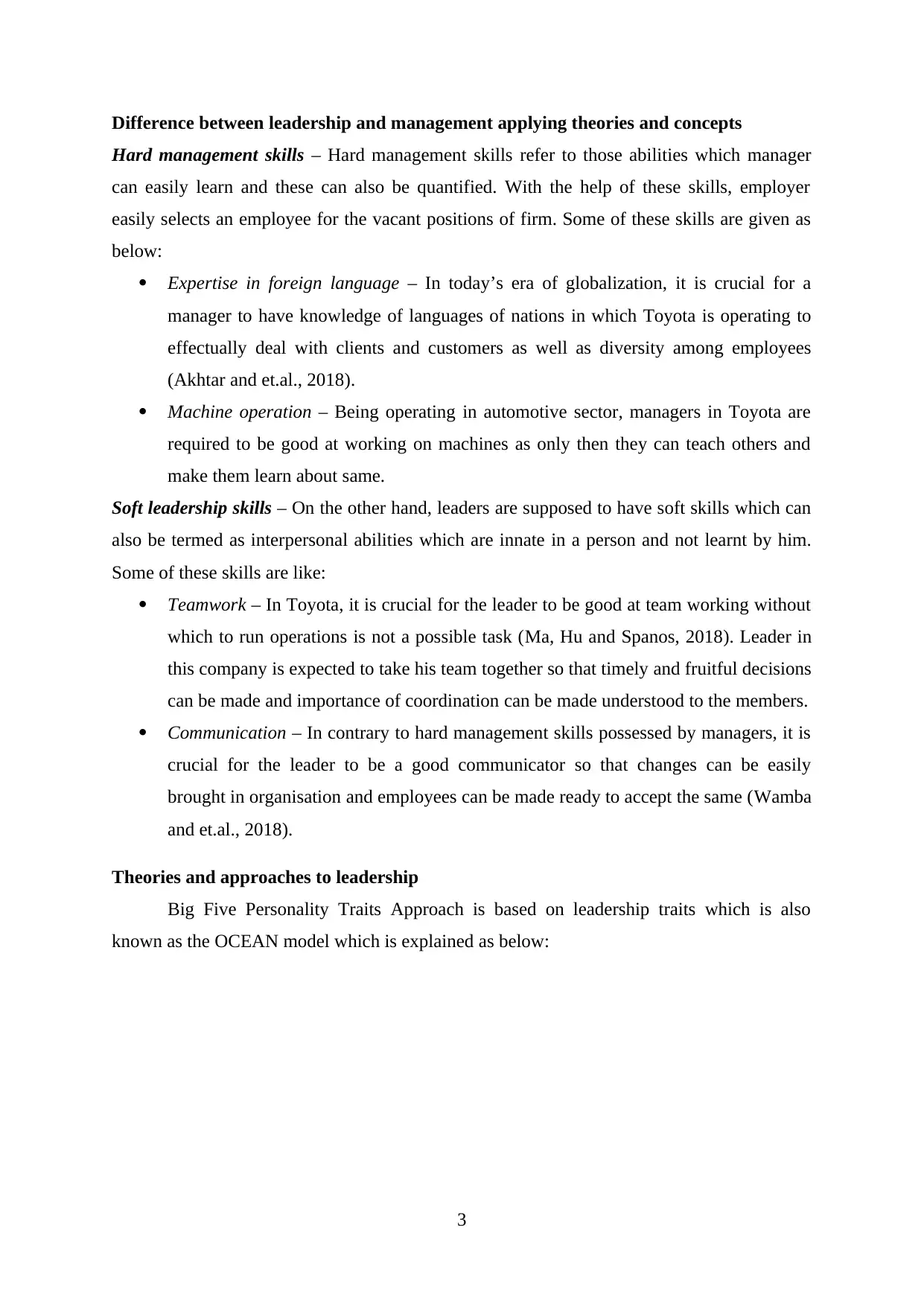
Difference between leadership and management applying theories and concepts
Hard management skills – Hard management skills refer to those abilities which manager
can easily learn and these can also be quantified. With the help of these skills, employer
easily selects an employee for the vacant positions of firm. Some of these skills are given as
below:
Expertise in foreign language – In today’s era of globalization, it is crucial for a
manager to have knowledge of languages of nations in which Toyota is operating to
effectually deal with clients and customers as well as diversity among employees
(Akhtar and et.al., 2018).
Machine operation – Being operating in automotive sector, managers in Toyota are
required to be good at working on machines as only then they can teach others and
make them learn about same.
Soft leadership skills – On the other hand, leaders are supposed to have soft skills which can
also be termed as interpersonal abilities which are innate in a person and not learnt by him.
Some of these skills are like:
Teamwork – In Toyota, it is crucial for the leader to be good at team working without
which to run operations is not a possible task (Ma, Hu and Spanos, 2018). Leader in
this company is expected to take his team together so that timely and fruitful decisions
can be made and importance of coordination can be made understood to the members.
Communication – In contrary to hard management skills possessed by managers, it is
crucial for the leader to be a good communicator so that changes can be easily
brought in organisation and employees can be made ready to accept the same (Wamba
and et.al., 2018).
Theories and approaches to leadership
Big Five Personality Traits Approach is based on leadership traits which is also
known as the OCEAN model which is explained as below:
3
Hard management skills – Hard management skills refer to those abilities which manager
can easily learn and these can also be quantified. With the help of these skills, employer
easily selects an employee for the vacant positions of firm. Some of these skills are given as
below:
Expertise in foreign language – In today’s era of globalization, it is crucial for a
manager to have knowledge of languages of nations in which Toyota is operating to
effectually deal with clients and customers as well as diversity among employees
(Akhtar and et.al., 2018).
Machine operation – Being operating in automotive sector, managers in Toyota are
required to be good at working on machines as only then they can teach others and
make them learn about same.
Soft leadership skills – On the other hand, leaders are supposed to have soft skills which can
also be termed as interpersonal abilities which are innate in a person and not learnt by him.
Some of these skills are like:
Teamwork – In Toyota, it is crucial for the leader to be good at team working without
which to run operations is not a possible task (Ma, Hu and Spanos, 2018). Leader in
this company is expected to take his team together so that timely and fruitful decisions
can be made and importance of coordination can be made understood to the members.
Communication – In contrary to hard management skills possessed by managers, it is
crucial for the leader to be a good communicator so that changes can be easily
brought in organisation and employees can be made ready to accept the same (Wamba
and et.al., 2018).
Theories and approaches to leadership
Big Five Personality Traits Approach is based on leadership traits which is also
known as the OCEAN model which is explained as below:
3
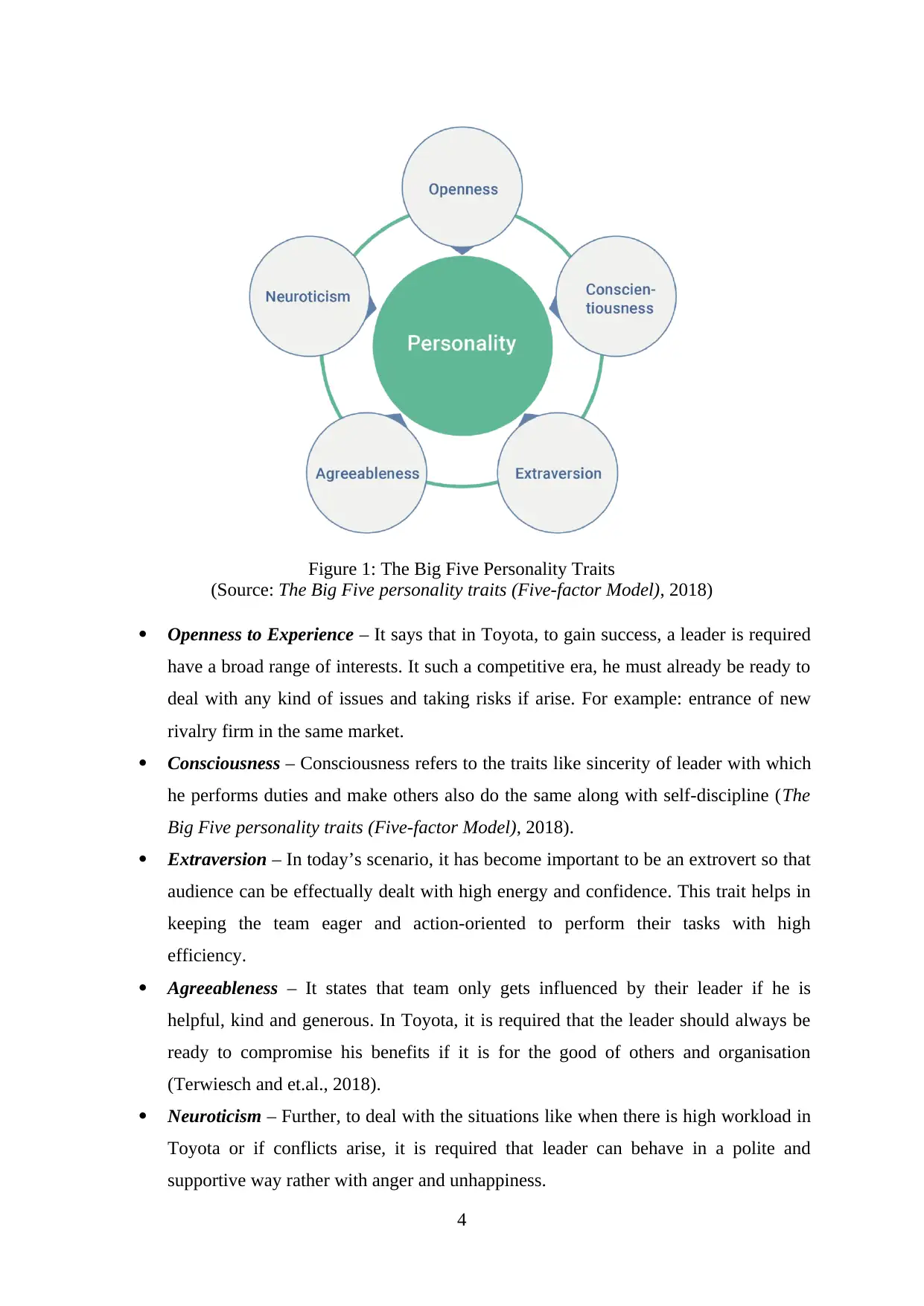
Figure 1: The Big Five Personality Traits
(Source: The Big Five personality traits (Five-factor Model), 2018)
Openness to Experience – It says that in Toyota, to gain success, a leader is required
have a broad range of interests. It such a competitive era, he must already be ready to
deal with any kind of issues and taking risks if arise. For example: entrance of new
rivalry firm in the same market.
Consciousness – Consciousness refers to the traits like sincerity of leader with which
he performs duties and make others also do the same along with self-discipline (The
Big Five personality traits (Five-factor Model), 2018).
Extraversion – In today’s scenario, it has become important to be an extrovert so that
audience can be effectually dealt with high energy and confidence. This trait helps in
keeping the team eager and action-oriented to perform their tasks with high
efficiency.
Agreeableness – It states that team only gets influenced by their leader if he is
helpful, kind and generous. In Toyota, it is required that the leader should always be
ready to compromise his benefits if it is for the good of others and organisation
(Terwiesch and et.al., 2018).
Neuroticism – Further, to deal with the situations like when there is high workload in
Toyota or if conflicts arise, it is required that leader can behave in a polite and
supportive way rather with anger and unhappiness.
4
(Source: The Big Five personality traits (Five-factor Model), 2018)
Openness to Experience – It says that in Toyota, to gain success, a leader is required
have a broad range of interests. It such a competitive era, he must already be ready to
deal with any kind of issues and taking risks if arise. For example: entrance of new
rivalry firm in the same market.
Consciousness – Consciousness refers to the traits like sincerity of leader with which
he performs duties and make others also do the same along with self-discipline (The
Big Five personality traits (Five-factor Model), 2018).
Extraversion – In today’s scenario, it has become important to be an extrovert so that
audience can be effectually dealt with high energy and confidence. This trait helps in
keeping the team eager and action-oriented to perform their tasks with high
efficiency.
Agreeableness – It states that team only gets influenced by their leader if he is
helpful, kind and generous. In Toyota, it is required that the leader should always be
ready to compromise his benefits if it is for the good of others and organisation
(Terwiesch and et.al., 2018).
Neuroticism – Further, to deal with the situations like when there is high workload in
Toyota or if conflicts arise, it is required that leader can behave in a polite and
supportive way rather with anger and unhappiness.
4
⊘ This is a preview!⊘
Do you want full access?
Subscribe today to unlock all pages.

Trusted by 1+ million students worldwide
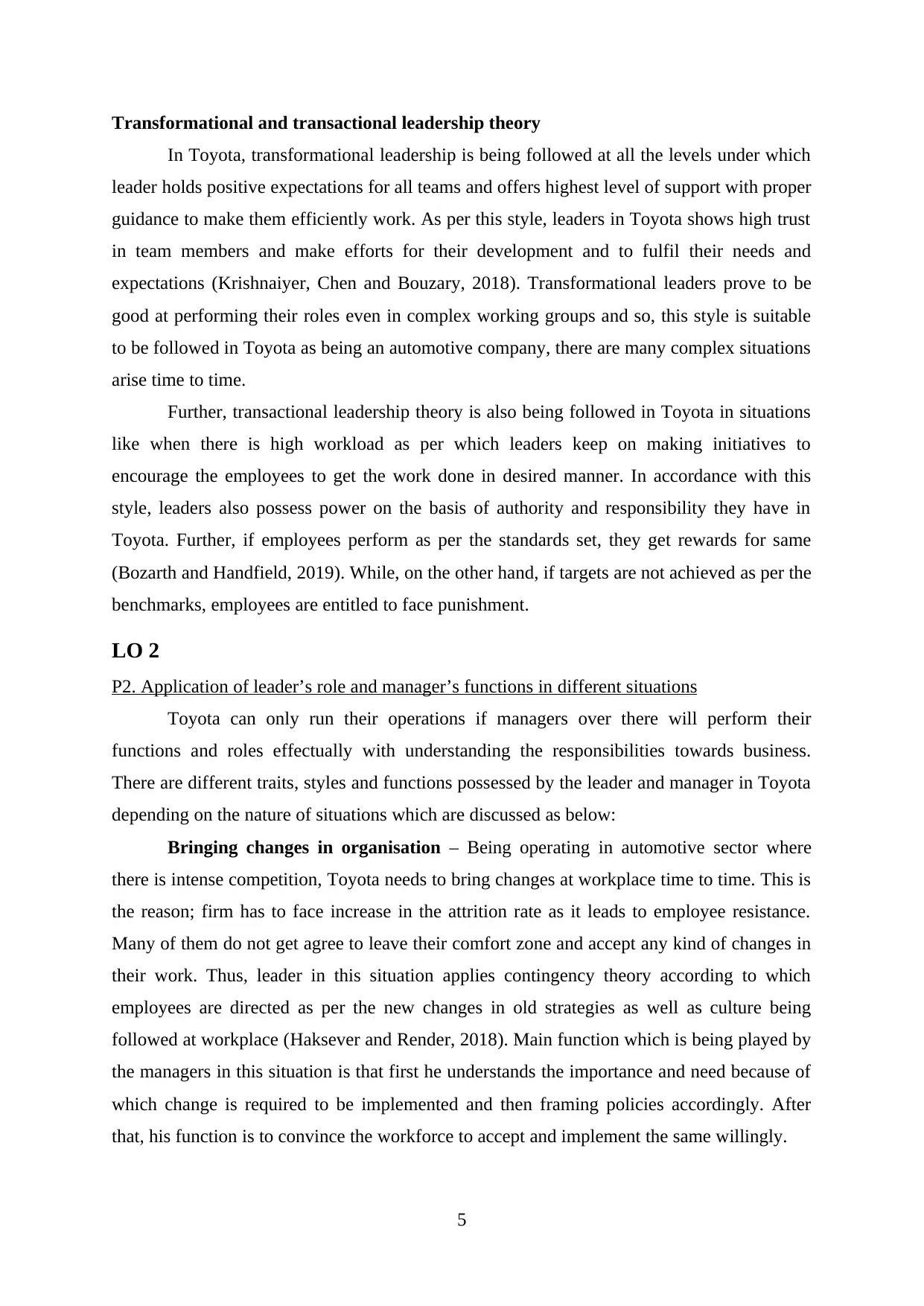
Transformational and transactional leadership theory
In Toyota, transformational leadership is being followed at all the levels under which
leader holds positive expectations for all teams and offers highest level of support with proper
guidance to make them efficiently work. As per this style, leaders in Toyota shows high trust
in team members and make efforts for their development and to fulfil their needs and
expectations (Krishnaiyer, Chen and Bouzary, 2018). Transformational leaders prove to be
good at performing their roles even in complex working groups and so, this style is suitable
to be followed in Toyota as being an automotive company, there are many complex situations
arise time to time.
Further, transactional leadership theory is also being followed in Toyota in situations
like when there is high workload as per which leaders keep on making initiatives to
encourage the employees to get the work done in desired manner. In accordance with this
style, leaders also possess power on the basis of authority and responsibility they have in
Toyota. Further, if employees perform as per the standards set, they get rewards for same
(Bozarth and Handfield, 2019). While, on the other hand, if targets are not achieved as per the
benchmarks, employees are entitled to face punishment.
LO 2
P2. Application of leader’s role and manager’s functions in different situations
Toyota can only run their operations if managers over there will perform their
functions and roles effectually with understanding the responsibilities towards business.
There are different traits, styles and functions possessed by the leader and manager in Toyota
depending on the nature of situations which are discussed as below:
Bringing changes in organisation – Being operating in automotive sector where
there is intense competition, Toyota needs to bring changes at workplace time to time. This is
the reason; firm has to face increase in the attrition rate as it leads to employee resistance.
Many of them do not get agree to leave their comfort zone and accept any kind of changes in
their work. Thus, leader in this situation applies contingency theory according to which
employees are directed as per the new changes in old strategies as well as culture being
followed at workplace (Haksever and Render, 2018). Main function which is being played by
the managers in this situation is that first he understands the importance and need because of
which change is required to be implemented and then framing policies accordingly. After
that, his function is to convince the workforce to accept and implement the same willingly.
5
In Toyota, transformational leadership is being followed at all the levels under which
leader holds positive expectations for all teams and offers highest level of support with proper
guidance to make them efficiently work. As per this style, leaders in Toyota shows high trust
in team members and make efforts for their development and to fulfil their needs and
expectations (Krishnaiyer, Chen and Bouzary, 2018). Transformational leaders prove to be
good at performing their roles even in complex working groups and so, this style is suitable
to be followed in Toyota as being an automotive company, there are many complex situations
arise time to time.
Further, transactional leadership theory is also being followed in Toyota in situations
like when there is high workload as per which leaders keep on making initiatives to
encourage the employees to get the work done in desired manner. In accordance with this
style, leaders also possess power on the basis of authority and responsibility they have in
Toyota. Further, if employees perform as per the standards set, they get rewards for same
(Bozarth and Handfield, 2019). While, on the other hand, if targets are not achieved as per the
benchmarks, employees are entitled to face punishment.
LO 2
P2. Application of leader’s role and manager’s functions in different situations
Toyota can only run their operations if managers over there will perform their
functions and roles effectually with understanding the responsibilities towards business.
There are different traits, styles and functions possessed by the leader and manager in Toyota
depending on the nature of situations which are discussed as below:
Bringing changes in organisation – Being operating in automotive sector where
there is intense competition, Toyota needs to bring changes at workplace time to time. This is
the reason; firm has to face increase in the attrition rate as it leads to employee resistance.
Many of them do not get agree to leave their comfort zone and accept any kind of changes in
their work. Thus, leader in this situation applies contingency theory according to which
employees are directed as per the new changes in old strategies as well as culture being
followed at workplace (Haksever and Render, 2018). Main function which is being played by
the managers in this situation is that first he understands the importance and need because of
which change is required to be implemented and then framing policies accordingly. After
that, his function is to convince the workforce to accept and implement the same willingly.
5
Paraphrase This Document
Need a fresh take? Get an instant paraphrase of this document with our AI Paraphraser
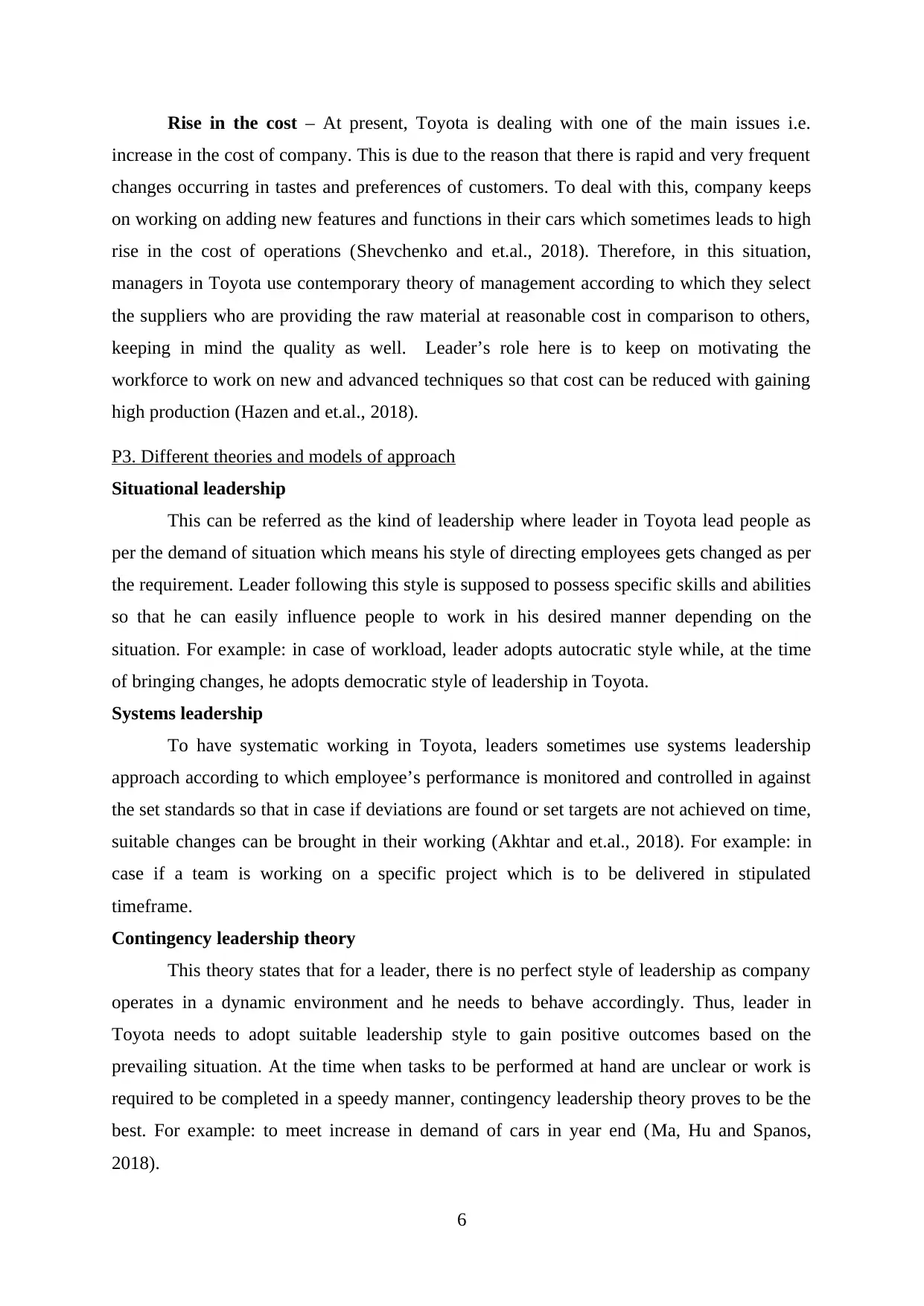
Rise in the cost – At present, Toyota is dealing with one of the main issues i.e.
increase in the cost of company. This is due to the reason that there is rapid and very frequent
changes occurring in tastes and preferences of customers. To deal with this, company keeps
on working on adding new features and functions in their cars which sometimes leads to high
rise in the cost of operations (Shevchenko and et.al., 2018). Therefore, in this situation,
managers in Toyota use contemporary theory of management according to which they select
the suppliers who are providing the raw material at reasonable cost in comparison to others,
keeping in mind the quality as well. Leader’s role here is to keep on motivating the
workforce to work on new and advanced techniques so that cost can be reduced with gaining
high production (Hazen and et.al., 2018).
P3. Different theories and models of approach
Situational leadership
This can be referred as the kind of leadership where leader in Toyota lead people as
per the demand of situation which means his style of directing employees gets changed as per
the requirement. Leader following this style is supposed to possess specific skills and abilities
so that he can easily influence people to work in his desired manner depending on the
situation. For example: in case of workload, leader adopts autocratic style while, at the time
of bringing changes, he adopts democratic style of leadership in Toyota.
Systems leadership
To have systematic working in Toyota, leaders sometimes use systems leadership
approach according to which employee’s performance is monitored and controlled in against
the set standards so that in case if deviations are found or set targets are not achieved on time,
suitable changes can be brought in their working (Akhtar and et.al., 2018). For example: in
case if a team is working on a specific project which is to be delivered in stipulated
timeframe.
Contingency leadership theory
This theory states that for a leader, there is no perfect style of leadership as company
operates in a dynamic environment and he needs to behave accordingly. Thus, leader in
Toyota needs to adopt suitable leadership style to gain positive outcomes based on the
prevailing situation. At the time when tasks to be performed at hand are unclear or work is
required to be completed in a speedy manner, contingency leadership theory proves to be the
best. For example: to meet increase in demand of cars in year end (Ma, Hu and Spanos,
2018).
6
increase in the cost of company. This is due to the reason that there is rapid and very frequent
changes occurring in tastes and preferences of customers. To deal with this, company keeps
on working on adding new features and functions in their cars which sometimes leads to high
rise in the cost of operations (Shevchenko and et.al., 2018). Therefore, in this situation,
managers in Toyota use contemporary theory of management according to which they select
the suppliers who are providing the raw material at reasonable cost in comparison to others,
keeping in mind the quality as well. Leader’s role here is to keep on motivating the
workforce to work on new and advanced techniques so that cost can be reduced with gaining
high production (Hazen and et.al., 2018).
P3. Different theories and models of approach
Situational leadership
This can be referred as the kind of leadership where leader in Toyota lead people as
per the demand of situation which means his style of directing employees gets changed as per
the requirement. Leader following this style is supposed to possess specific skills and abilities
so that he can easily influence people to work in his desired manner depending on the
situation. For example: in case of workload, leader adopts autocratic style while, at the time
of bringing changes, he adopts democratic style of leadership in Toyota.
Systems leadership
To have systematic working in Toyota, leaders sometimes use systems leadership
approach according to which employee’s performance is monitored and controlled in against
the set standards so that in case if deviations are found or set targets are not achieved on time,
suitable changes can be brought in their working (Akhtar and et.al., 2018). For example: in
case if a team is working on a specific project which is to be delivered in stipulated
timeframe.
Contingency leadership theory
This theory states that for a leader, there is no perfect style of leadership as company
operates in a dynamic environment and he needs to behave accordingly. Thus, leader in
Toyota needs to adopt suitable leadership style to gain positive outcomes based on the
prevailing situation. At the time when tasks to be performed at hand are unclear or work is
required to be completed in a speedy manner, contingency leadership theory proves to be the
best. For example: to meet increase in demand of cars in year end (Ma, Hu and Spanos,
2018).
6
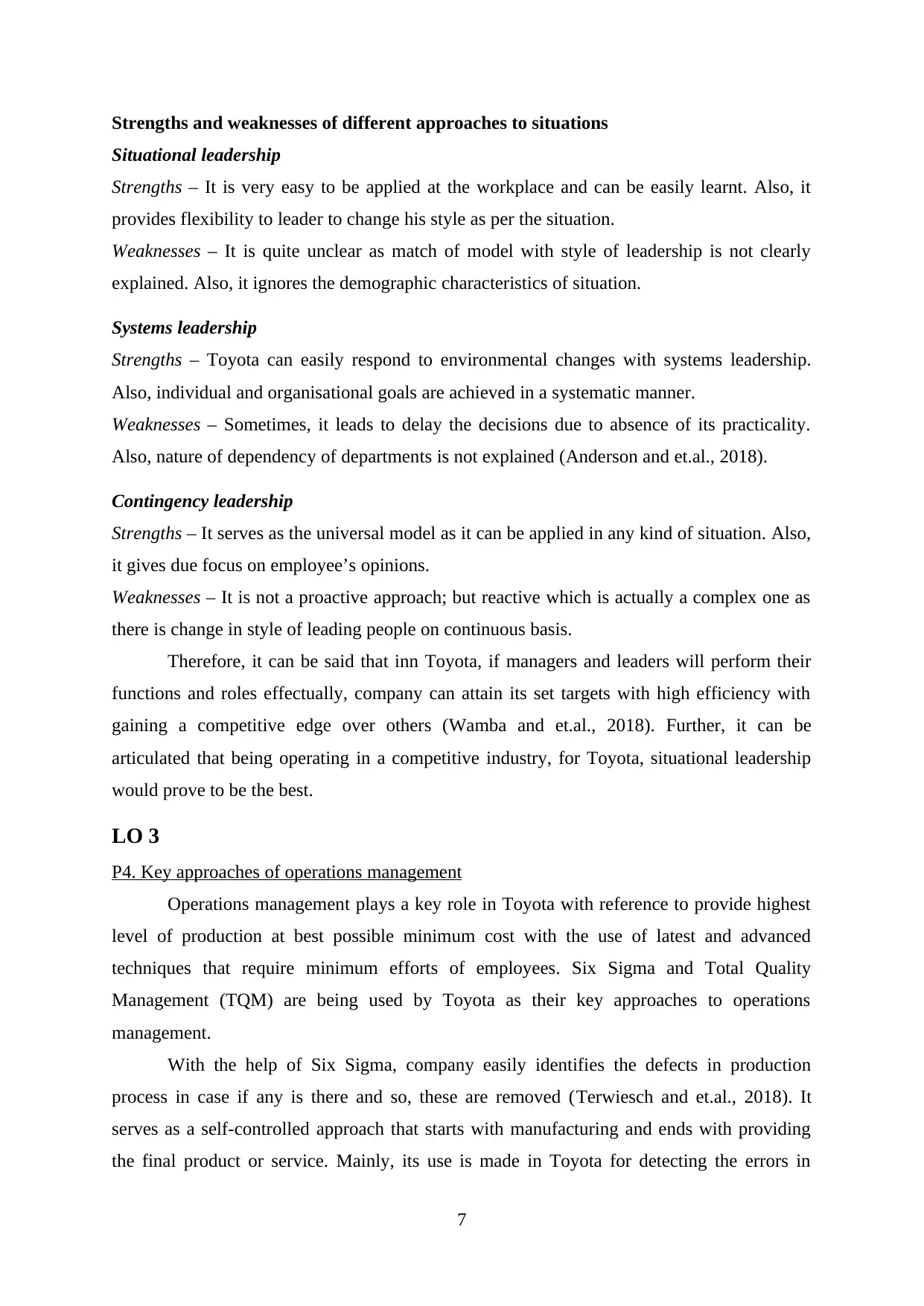
Strengths and weaknesses of different approaches to situations
Situational leadership
Strengths – It is very easy to be applied at the workplace and can be easily learnt. Also, it
provides flexibility to leader to change his style as per the situation.
Weaknesses – It is quite unclear as match of model with style of leadership is not clearly
explained. Also, it ignores the demographic characteristics of situation.
Systems leadership
Strengths – Toyota can easily respond to environmental changes with systems leadership.
Also, individual and organisational goals are achieved in a systematic manner.
Weaknesses – Sometimes, it leads to delay the decisions due to absence of its practicality.
Also, nature of dependency of departments is not explained (Anderson and et.al., 2018).
Contingency leadership
Strengths – It serves as the universal model as it can be applied in any kind of situation. Also,
it gives due focus on employee’s opinions.
Weaknesses – It is not a proactive approach; but reactive which is actually a complex one as
there is change in style of leading people on continuous basis.
Therefore, it can be said that inn Toyota, if managers and leaders will perform their
functions and roles effectually, company can attain its set targets with high efficiency with
gaining a competitive edge over others (Wamba and et.al., 2018). Further, it can be
articulated that being operating in a competitive industry, for Toyota, situational leadership
would prove to be the best.
LO 3
P4. Key approaches of operations management
Operations management plays a key role in Toyota with reference to provide highest
level of production at best possible minimum cost with the use of latest and advanced
techniques that require minimum efforts of employees. Six Sigma and Total Quality
Management (TQM) are being used by Toyota as their key approaches to operations
management.
With the help of Six Sigma, company easily identifies the defects in production
process in case if any is there and so, these are removed (Terwiesch and et.al., 2018). It
serves as a self-controlled approach that starts with manufacturing and ends with providing
the final product or service. Mainly, its use is made in Toyota for detecting the errors in
7
Situational leadership
Strengths – It is very easy to be applied at the workplace and can be easily learnt. Also, it
provides flexibility to leader to change his style as per the situation.
Weaknesses – It is quite unclear as match of model with style of leadership is not clearly
explained. Also, it ignores the demographic characteristics of situation.
Systems leadership
Strengths – Toyota can easily respond to environmental changes with systems leadership.
Also, individual and organisational goals are achieved in a systematic manner.
Weaknesses – Sometimes, it leads to delay the decisions due to absence of its practicality.
Also, nature of dependency of departments is not explained (Anderson and et.al., 2018).
Contingency leadership
Strengths – It serves as the universal model as it can be applied in any kind of situation. Also,
it gives due focus on employee’s opinions.
Weaknesses – It is not a proactive approach; but reactive which is actually a complex one as
there is change in style of leading people on continuous basis.
Therefore, it can be said that inn Toyota, if managers and leaders will perform their
functions and roles effectually, company can attain its set targets with high efficiency with
gaining a competitive edge over others (Wamba and et.al., 2018). Further, it can be
articulated that being operating in a competitive industry, for Toyota, situational leadership
would prove to be the best.
LO 3
P4. Key approaches of operations management
Operations management plays a key role in Toyota with reference to provide highest
level of production at best possible minimum cost with the use of latest and advanced
techniques that require minimum efforts of employees. Six Sigma and Total Quality
Management (TQM) are being used by Toyota as their key approaches to operations
management.
With the help of Six Sigma, company easily identifies the defects in production
process in case if any is there and so, these are removed (Terwiesch and et.al., 2018). It
serves as a self-controlled approach that starts with manufacturing and ends with providing
the final product or service. Mainly, its use is made in Toyota for detecting the errors in
7
⊘ This is a preview!⊘
Do you want full access?
Subscribe today to unlock all pages.

Trusted by 1+ million students worldwide
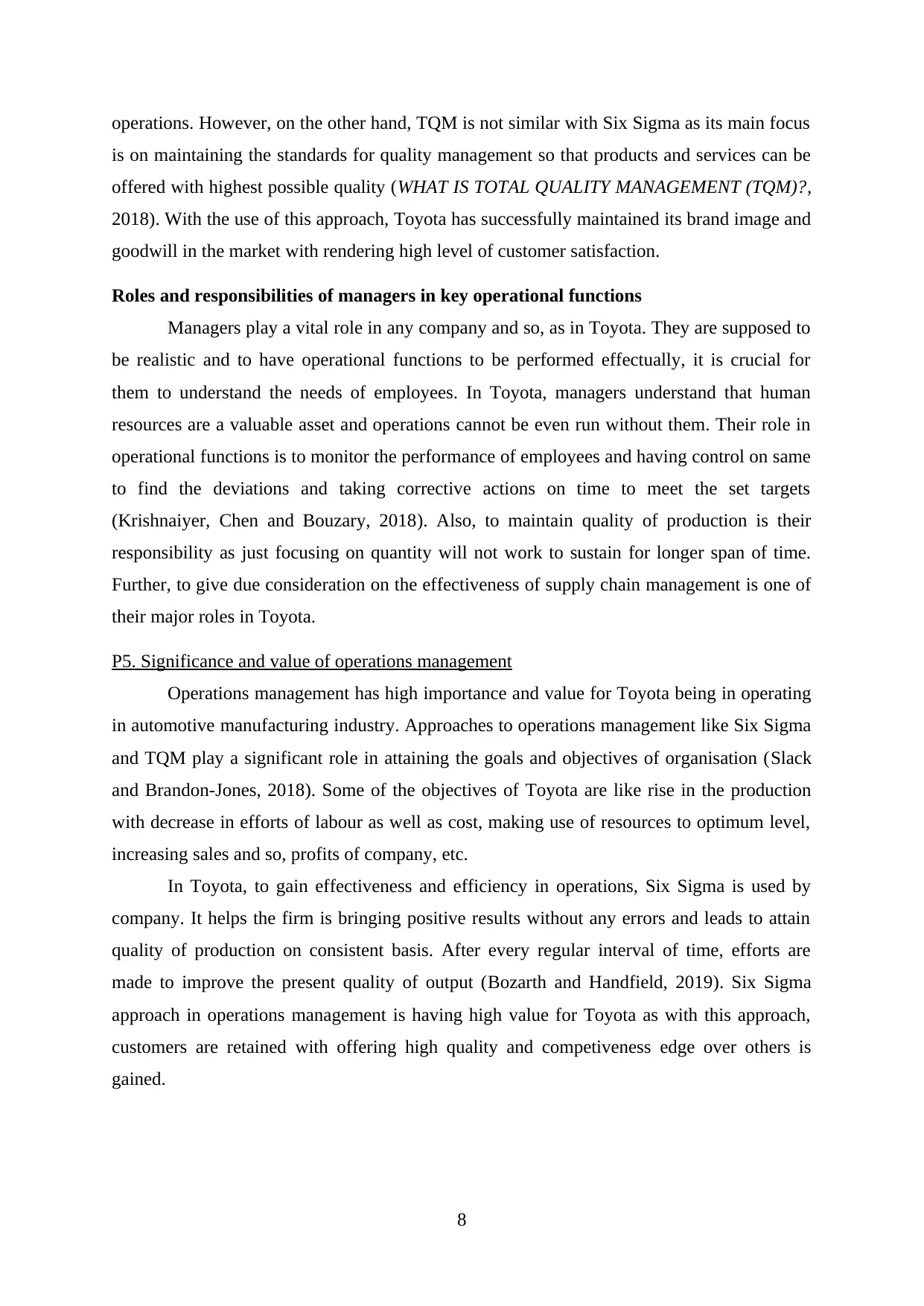
operations. However, on the other hand, TQM is not similar with Six Sigma as its main focus
is on maintaining the standards for quality management so that products and services can be
offered with highest possible quality (WHAT IS TOTAL QUALITY MANAGEMENT (TQM)?,
2018). With the use of this approach, Toyota has successfully maintained its brand image and
goodwill in the market with rendering high level of customer satisfaction.
Roles and responsibilities of managers in key operational functions
Managers play a vital role in any company and so, as in Toyota. They are supposed to
be realistic and to have operational functions to be performed effectually, it is crucial for
them to understand the needs of employees. In Toyota, managers understand that human
resources are a valuable asset and operations cannot be even run without them. Their role in
operational functions is to monitor the performance of employees and having control on same
to find the deviations and taking corrective actions on time to meet the set targets
(Krishnaiyer, Chen and Bouzary, 2018). Also, to maintain quality of production is their
responsibility as just focusing on quantity will not work to sustain for longer span of time.
Further, to give due consideration on the effectiveness of supply chain management is one of
their major roles in Toyota.
P5. Significance and value of operations management
Operations management has high importance and value for Toyota being in operating
in automotive manufacturing industry. Approaches to operations management like Six Sigma
and TQM play a significant role in attaining the goals and objectives of organisation (Slack
and Brandon-Jones, 2018). Some of the objectives of Toyota are like rise in the production
with decrease in efforts of labour as well as cost, making use of resources to optimum level,
increasing sales and so, profits of company, etc.
In Toyota, to gain effectiveness and efficiency in operations, Six Sigma is used by
company. It helps the firm is bringing positive results without any errors and leads to attain
quality of production on consistent basis. After every regular interval of time, efforts are
made to improve the present quality of output (Bozarth and Handfield, 2019). Six Sigma
approach in operations management is having high value for Toyota as with this approach,
customers are retained with offering high quality and competiveness edge over others is
gained.
8
is on maintaining the standards for quality management so that products and services can be
offered with highest possible quality (WHAT IS TOTAL QUALITY MANAGEMENT (TQM)?,
2018). With the use of this approach, Toyota has successfully maintained its brand image and
goodwill in the market with rendering high level of customer satisfaction.
Roles and responsibilities of managers in key operational functions
Managers play a vital role in any company and so, as in Toyota. They are supposed to
be realistic and to have operational functions to be performed effectually, it is crucial for
them to understand the needs of employees. In Toyota, managers understand that human
resources are a valuable asset and operations cannot be even run without them. Their role in
operational functions is to monitor the performance of employees and having control on same
to find the deviations and taking corrective actions on time to meet the set targets
(Krishnaiyer, Chen and Bouzary, 2018). Also, to maintain quality of production is their
responsibility as just focusing on quantity will not work to sustain for longer span of time.
Further, to give due consideration on the effectiveness of supply chain management is one of
their major roles in Toyota.
P5. Significance and value of operations management
Operations management has high importance and value for Toyota being in operating
in automotive manufacturing industry. Approaches to operations management like Six Sigma
and TQM play a significant role in attaining the goals and objectives of organisation (Slack
and Brandon-Jones, 2018). Some of the objectives of Toyota are like rise in the production
with decrease in efforts of labour as well as cost, making use of resources to optimum level,
increasing sales and so, profits of company, etc.
In Toyota, to gain effectiveness and efficiency in operations, Six Sigma is used by
company. It helps the firm is bringing positive results without any errors and leads to attain
quality of production on consistent basis. After every regular interval of time, efforts are
made to improve the present quality of output (Bozarth and Handfield, 2019). Six Sigma
approach in operations management is having high value for Toyota as with this approach,
customers are retained with offering high quality and competiveness edge over others is
gained.
8
Paraphrase This Document
Need a fresh take? Get an instant paraphrase of this document with our AI Paraphraser
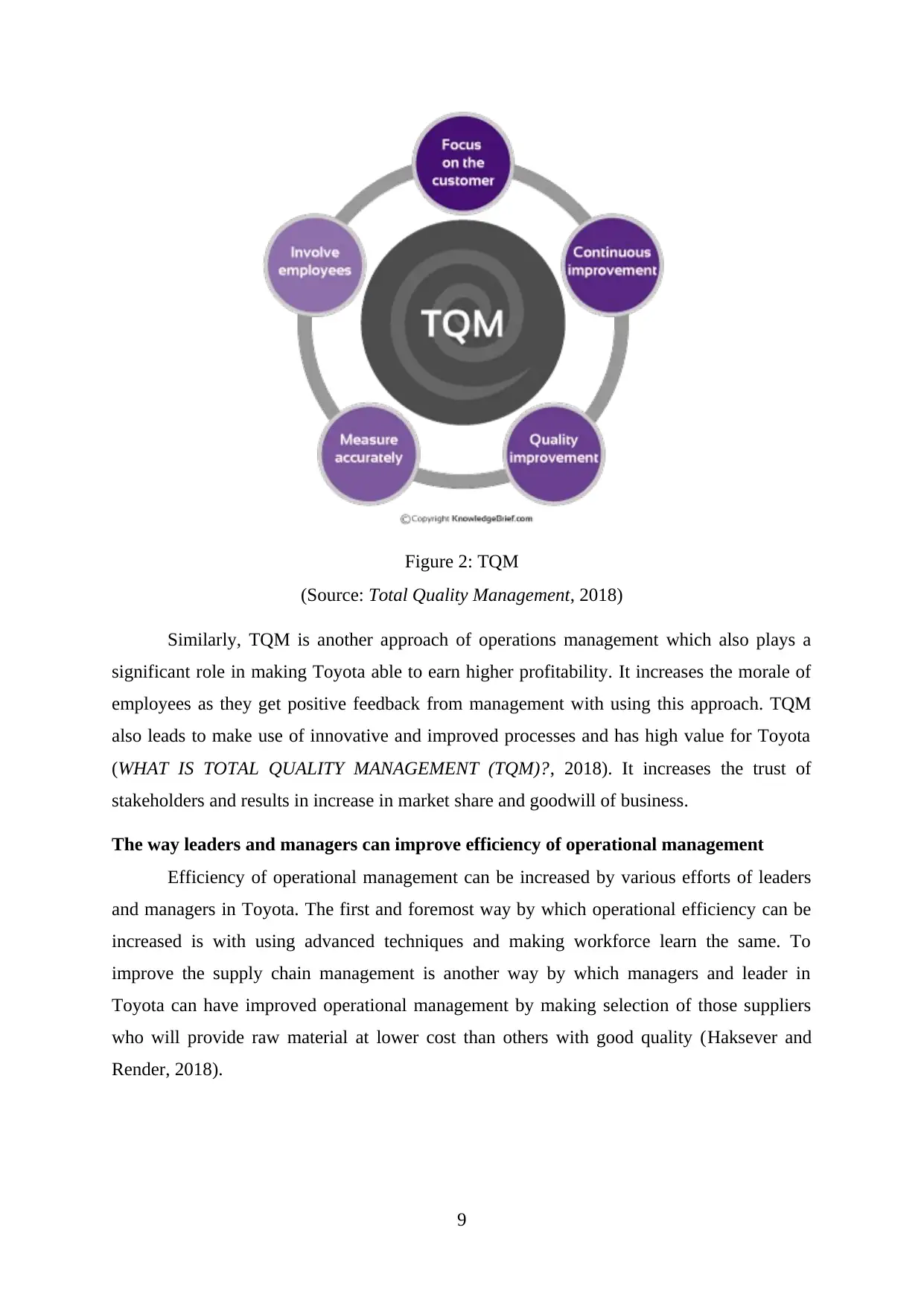
Figure 2: TQM
(Source: Total Quality Management, 2018)
Similarly, TQM is another approach of operations management which also plays a
significant role in making Toyota able to earn higher profitability. It increases the morale of
employees as they get positive feedback from management with using this approach. TQM
also leads to make use of innovative and improved processes and has high value for Toyota
(WHAT IS TOTAL QUALITY MANAGEMENT (TQM)?, 2018). It increases the trust of
stakeholders and results in increase in market share and goodwill of business.
The way leaders and managers can improve efficiency of operational management
Efficiency of operational management can be increased by various efforts of leaders
and managers in Toyota. The first and foremost way by which operational efficiency can be
increased is with using advanced techniques and making workforce learn the same. To
improve the supply chain management is another way by which managers and leader in
Toyota can have improved operational management by making selection of those suppliers
who will provide raw material at lower cost than others with good quality (Haksever and
Render, 2018).
9
(Source: Total Quality Management, 2018)
Similarly, TQM is another approach of operations management which also plays a
significant role in making Toyota able to earn higher profitability. It increases the morale of
employees as they get positive feedback from management with using this approach. TQM
also leads to make use of innovative and improved processes and has high value for Toyota
(WHAT IS TOTAL QUALITY MANAGEMENT (TQM)?, 2018). It increases the trust of
stakeholders and results in increase in market share and goodwill of business.
The way leaders and managers can improve efficiency of operational management
Efficiency of operational management can be increased by various efforts of leaders
and managers in Toyota. The first and foremost way by which operational efficiency can be
increased is with using advanced techniques and making workforce learn the same. To
improve the supply chain management is another way by which managers and leader in
Toyota can have improved operational management by making selection of those suppliers
who will provide raw material at lower cost than others with good quality (Haksever and
Render, 2018).
9
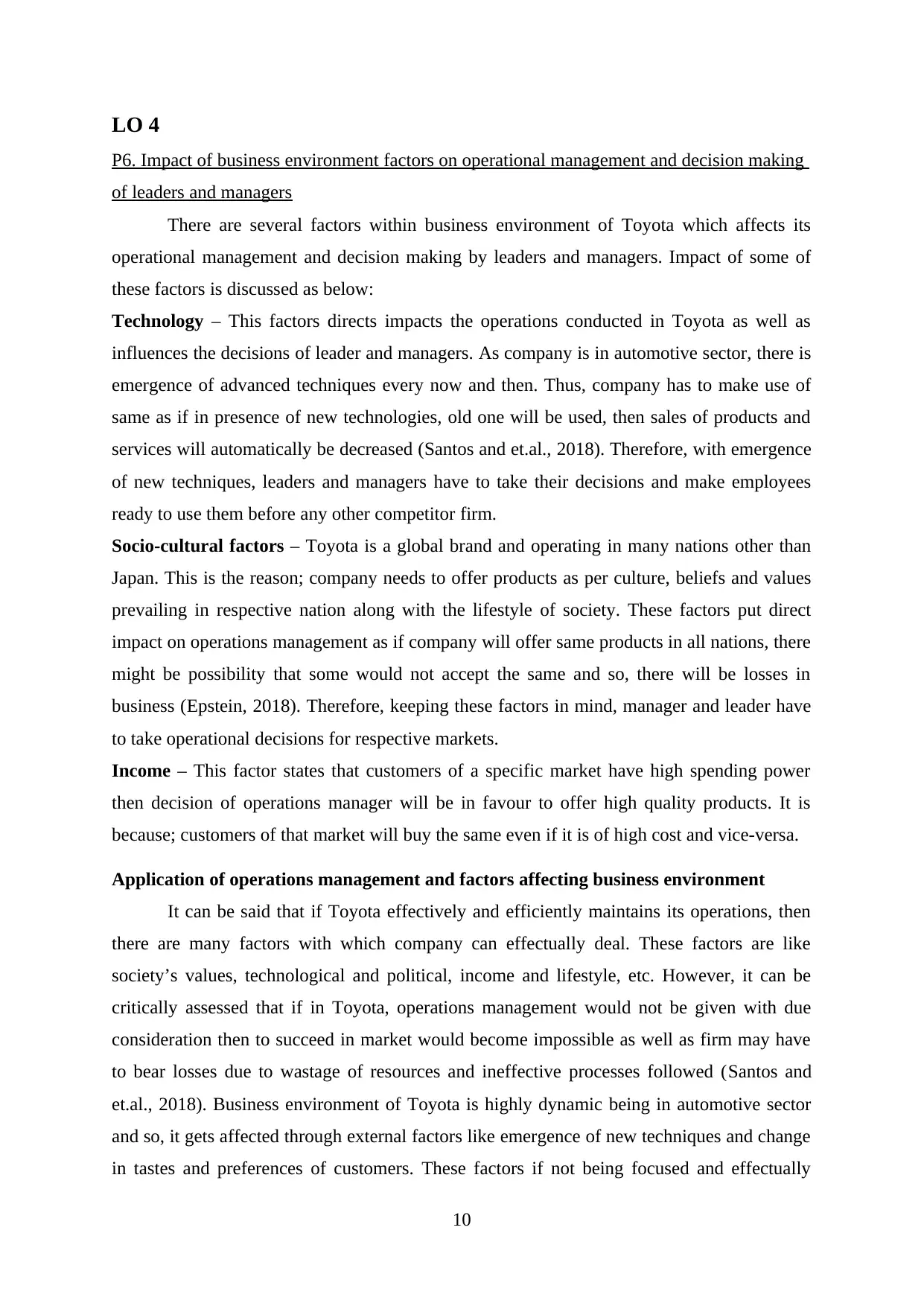
LO 4
P6. Impact of business environment factors on operational management and decision making
of leaders and managers
There are several factors within business environment of Toyota which affects its
operational management and decision making by leaders and managers. Impact of some of
these factors is discussed as below:
Technology – This factors directs impacts the operations conducted in Toyota as well as
influences the decisions of leader and managers. As company is in automotive sector, there is
emergence of advanced techniques every now and then. Thus, company has to make use of
same as if in presence of new technologies, old one will be used, then sales of products and
services will automatically be decreased (Santos and et.al., 2018). Therefore, with emergence
of new techniques, leaders and managers have to take their decisions and make employees
ready to use them before any other competitor firm.
Socio-cultural factors – Toyota is a global brand and operating in many nations other than
Japan. This is the reason; company needs to offer products as per culture, beliefs and values
prevailing in respective nation along with the lifestyle of society. These factors put direct
impact on operations management as if company will offer same products in all nations, there
might be possibility that some would not accept the same and so, there will be losses in
business (Epstein, 2018). Therefore, keeping these factors in mind, manager and leader have
to take operational decisions for respective markets.
Income – This factor states that customers of a specific market have high spending power
then decision of operations manager will be in favour to offer high quality products. It is
because; customers of that market will buy the same even if it is of high cost and vice-versa.
Application of operations management and factors affecting business environment
It can be said that if Toyota effectively and efficiently maintains its operations, then
there are many factors with which company can effectually deal. These factors are like
society’s values, technological and political, income and lifestyle, etc. However, it can be
critically assessed that if in Toyota, operations management would not be given with due
consideration then to succeed in market would become impossible as well as firm may have
to bear losses due to wastage of resources and ineffective processes followed (Santos and
et.al., 2018). Business environment of Toyota is highly dynamic being in automotive sector
and so, it gets affected through external factors like emergence of new techniques and change
in tastes and preferences of customers. These factors if not being focused and effectually
10
P6. Impact of business environment factors on operational management and decision making
of leaders and managers
There are several factors within business environment of Toyota which affects its
operational management and decision making by leaders and managers. Impact of some of
these factors is discussed as below:
Technology – This factors directs impacts the operations conducted in Toyota as well as
influences the decisions of leader and managers. As company is in automotive sector, there is
emergence of advanced techniques every now and then. Thus, company has to make use of
same as if in presence of new technologies, old one will be used, then sales of products and
services will automatically be decreased (Santos and et.al., 2018). Therefore, with emergence
of new techniques, leaders and managers have to take their decisions and make employees
ready to use them before any other competitor firm.
Socio-cultural factors – Toyota is a global brand and operating in many nations other than
Japan. This is the reason; company needs to offer products as per culture, beliefs and values
prevailing in respective nation along with the lifestyle of society. These factors put direct
impact on operations management as if company will offer same products in all nations, there
might be possibility that some would not accept the same and so, there will be losses in
business (Epstein, 2018). Therefore, keeping these factors in mind, manager and leader have
to take operational decisions for respective markets.
Income – This factor states that customers of a specific market have high spending power
then decision of operations manager will be in favour to offer high quality products. It is
because; customers of that market will buy the same even if it is of high cost and vice-versa.
Application of operations management and factors affecting business environment
It can be said that if Toyota effectively and efficiently maintains its operations, then
there are many factors with which company can effectually deal. These factors are like
society’s values, technological and political, income and lifestyle, etc. However, it can be
critically assessed that if in Toyota, operations management would not be given with due
consideration then to succeed in market would become impossible as well as firm may have
to bear losses due to wastage of resources and ineffective processes followed (Santos and
et.al., 2018). Business environment of Toyota is highly dynamic being in automotive sector
and so, it gets affected through external factors like emergence of new techniques and change
in tastes and preferences of customers. These factors if not being focused and effectually
10
⊘ This is a preview!⊘
Do you want full access?
Subscribe today to unlock all pages.

Trusted by 1+ million students worldwide
1 out of 15
Related Documents
Your All-in-One AI-Powered Toolkit for Academic Success.
+13062052269
info@desklib.com
Available 24*7 on WhatsApp / Email
![[object Object]](/_next/static/media/star-bottom.7253800d.svg)
Unlock your academic potential
Copyright © 2020–2025 A2Z Services. All Rights Reserved. Developed and managed by ZUCOL.





